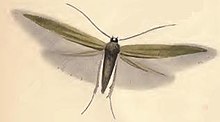Coleophora paripennella is a moth of the family Coleophoridae. It is found in most of Europe, except the Iberian Peninsula and Balkan Peninsula.
| Coleophora paripennella | |
|---|---|

| |
| Scientific classification | |
| Domain: | Eukaryota |
| Kingdom: | Animalia |
| Phylum: | Arthropoda |
| Class: | Insecta |
| Order: | Lepidoptera |
| Family: | Coleophoridae |
| Genus: | Coleophora |
| Species: | C. paripennella
|
| Binomial name | |
| Coleophora paripennella | |
| Synonyms | |
| |

The wingspan is 10–13 mm. Adults are metallic bronze with white-tipped dark antennae. Coleophora species have narrow blunt to pointed forewings and a weakly defined tornus. The hindwings are narrow-elongate and very long-fringed. The upper surfaces have neither a discal spot nor transverse lines. Each abdomen segment of the abdomen has paired patches of tiny spines which show through the scales. The resting position is horizontal with the front end raised and the cilia give the hind tip a frayed and upturned look if the wings are rolled around the body. C. paripennella characteristics include: Head shining greyish bronze. Antennae dark fuscous, apex white. Forewings rather dark fuscous, more or less bronzy-shining. Hindwings dark grey.[2]
They are on wing from July to August.[3]
The larvae feed on Arctium, Arnica, Carduus, Carlina, Centaurea jacea, Centaurea nigra, Cirsium arvense, Saussurea, Serratula tinctoria and Solidago species.[4] Full-grown larvae can be from the end of May to early June.
References
edit- ^ "Coleophora paripennella Zeller, 1839". Fauna Europaea. Retrieved 12 August 2019.
- ^ Meyrick, E., 1895 A Handbook of British Lepidoptera MacMillan, London pdf This article incorporates text from this source, which is in the public domain. Keys and description
- ^ Kimber, Ian. "37.106 BF560 Coleophora paripennella Zeller, 1839". UKmoths. Retrieved 12 August 2019.
- ^ Ellis, W N. "Coleophora paripennella Zeller, 1839 dark thistle case-bearer". Plant Parasites of Europe. Retrieved 12 August 2019.
External links
edit